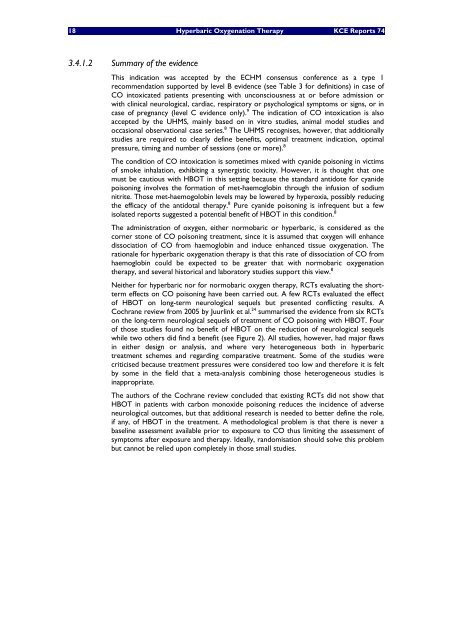Download the full report (130 p.)
Download the full report (130 p.)
Download the full report (130 p.)
Create successful ePaper yourself
Turn your PDF publications into a flip-book with our unique Google optimized e-Paper software.
18 Hyperbaric Oxygenation Therapy KCE Reports 74<br />
3.4.1.2 Summary of <strong>the</strong> evidence<br />
This indication was accepted by <strong>the</strong> ECHM consensus conference as a type 1<br />
recommendation supported by level B evidence (see Table 3 for definitions) in case of<br />
CO intoxicated patients presenting with unconsciousness at or before admission or<br />
with clinical neurological, cardiac, respiratory or psychological symptoms or signs, or in<br />
case of pregnancy (level C evidence only). 9 The indication of CO intoxication is also<br />
accepted by <strong>the</strong> UHMS, mainly based on in vitro studies, animal model studies and<br />
occasional observational case series. 8 The UHMS recognises, however, that additionally<br />
studies are required to clearly define benefits, optimal treatment indication, optimal<br />
pressure, timing and number of sessions (one or more). 8<br />
The condition of CO intoxication is sometimes mixed with cyanide poisoning in victims<br />
of smoke inhalation, exhibiting a synergistic toxicity. However, it is thought that one<br />
must be cautious with HBOT in this setting because <strong>the</strong> standard antidote for cyanide<br />
poisoning involves <strong>the</strong> formation of met-haemoglobin through <strong>the</strong> infusion of sodium<br />
nitrite. Those met-haemogolobin levels may be lowered by hyperoxia, possibly reducing<br />
<strong>the</strong> efficacy of <strong>the</strong> antidotal <strong>the</strong>rapy. 8 Pure cyanide poisoning is infrequent but a few<br />
isolated <strong>report</strong>s suggested a potential benefit of HBOT in this condition. 8<br />
The administration of oxygen, ei<strong>the</strong>r normobaric or hyperbaric, is considered as <strong>the</strong><br />
corner stone of CO poisoning treatment, since it is assumed that oxygen will enhance<br />
dissociation of CO from haemoglobin and induce enhanced tissue oxygenation. The<br />
rationale for hyperbaric oxygenation <strong>the</strong>rapy is that this rate of dissociation of CO from<br />
haemoglobin could be expected to be greater that with normobaric oxygenation<br />
<strong>the</strong>rapy, and several historical and laboratory studies support this view. 8<br />
Nei<strong>the</strong>r for hyperbaric nor for normobaric oxygen <strong>the</strong>rapy, RCTs evaluating <strong>the</strong> shortterm<br />
effects on CO poisoning have been carried out. A few RCTs evaluated <strong>the</strong> effect<br />
of HBOT on long-term neurological sequels but presented conflicting results. A<br />
Cochrane review from 2005 by Juurlink et al. 24 summarised <strong>the</strong> evidence from six RCTs<br />
on <strong>the</strong> long-term neurological sequels of treatment of CO poisoning with HBOT. Four<br />
of those studies found no benefit of HBOT on <strong>the</strong> reduction of neurological sequels<br />
while two o<strong>the</strong>rs did find a benefit (see Figure 2). All studies, however, had major flaws<br />
in ei<strong>the</strong>r design or analysis, and where very heterogeneous both in hyperbaric<br />
treatment schemes and regarding comparative treatment. Some of <strong>the</strong> studies were<br />
criticised because treatment pressures were considered too low and <strong>the</strong>refore it is felt<br />
by some in <strong>the</strong> field that a meta-analysis combining those heterogeneous studies is<br />
inappropriate.<br />
The authors of <strong>the</strong> Cochrane review concluded that existing RCTs did not show that<br />
HBOT in patients with carbon monoxide poisoning reduces <strong>the</strong> incidence of adverse<br />
neurological outcomes, but that additional research is needed to better define <strong>the</strong> role,<br />
if any, of HBOT in <strong>the</strong> treatment. A methodological problem is that <strong>the</strong>re is never a<br />
baseline assessment available prior to exposure to CO thus limiting <strong>the</strong> assessment of<br />
symptoms after exposure and <strong>the</strong>rapy. Ideally, randomisation should solve this problem<br />
but cannot be relied upon completely in those small studies.

















